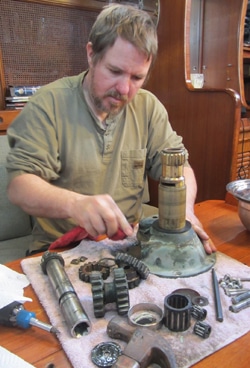
Del Viento- winches
The 1970s have long been maligned for their negative contributions to humanity, things like the Vietnam war, 20-percent mortgage interest rates, and disco. But what most historians fail to include in this list is our 1978 Lewmar 48 self-tailing winches.
Del Viento‘s got two of them, one on each side of her cockpit. They’re big, they’re black, and they’re stout. Several times, fellow boaters have complimented them. I always acknowledged the compliment with a simple thank you, but I’ve always thought to myself: Oh yes, they are damn nice.
Indeed, without them Del Viento wouldn’t look half as serious as she does. Her coamings swell where the Lewmars are attached, to accommodate their big footprint. As a prospective buyer, these winches spoke to me: Just look at us! Nobody would put us on a 40-foot boat that wasn’t strong and ready for big loads.
I recently serviced them for the first time.
It was easy enough to start: nine Allen screws, three sets of three. They loosened easily and in turn released the top cap and both halves of the self-tailing cleat. I then lifted off the cast-aluminum drum to expose a solid bronze base housing the main drive shaft and two sets of gears fitted neatly at the bottom.
Now I’ve rebuilt winches before, different sizes and makes. To get those two sets of gears off (and to expose the pawls and springs between them), I had only to remove the vertical axles that held them captive. But for the life of me, I couldn’t see any way to remove these axles. Only after a long, difficult search online, having tried a bunch of key words and having waded through about a dozen online forum discussions on winches, and having returned to the cockpit several times to confirm what I was seeing, did I turn up a PDF of a tattered manual for our vintage Lewmar 48. There in that ancient record, in clear monospace, were instructions that validated the worse-case scenario I’d stumbled on in my online search: these gear axles are pressed in from the bottom and it takes a punch and a hammer to knock them back out, through the bottom. By design, the winch must be completely removed from the boat for servicing.
Isn’t that absurd? What were the 1970s Lewmar engineers and designers thinking? Have they never owned a boat? Has anyone else come across a design like this?
In the end, I recruited Windy’s small arms and hands to reach into the underside of our coaming and hold each nut while I loosened it from above. After completely cleaning, oiling, and greasing each winch, I re-bedded them and we reinstalled them.
Once I finished the first winch, I did notice the word England forged into the top. So maybe it’s not simply a 1970s thing, but a 1970s British thing…
After all, in America S&S designed Del Viento in the 1970s—and there was even Star Wars, Farrah Fawcet, and bean bags. But apparently, overseas it was the decade of IRA violence, the infamous 1979 Fastnet Race, and the Lewmar 48 winch that must be completely removed from a boat to be serviced.
–MR
I__n our twenties, we traded our boat for a house and our freedom for careers. In our thirties, we slumbered through the American dream. In our forties, we woke and traded our house for a boat and our careers for freedom. And here we are. Follow along at http://www.logofdelviento.blogspot.com/








